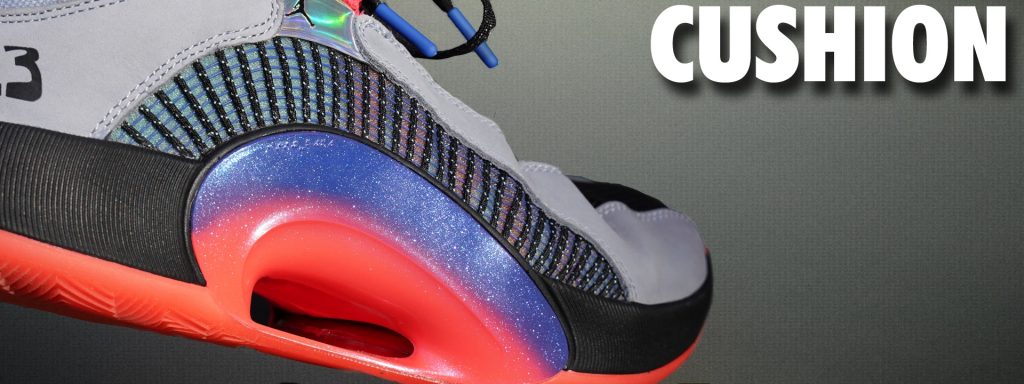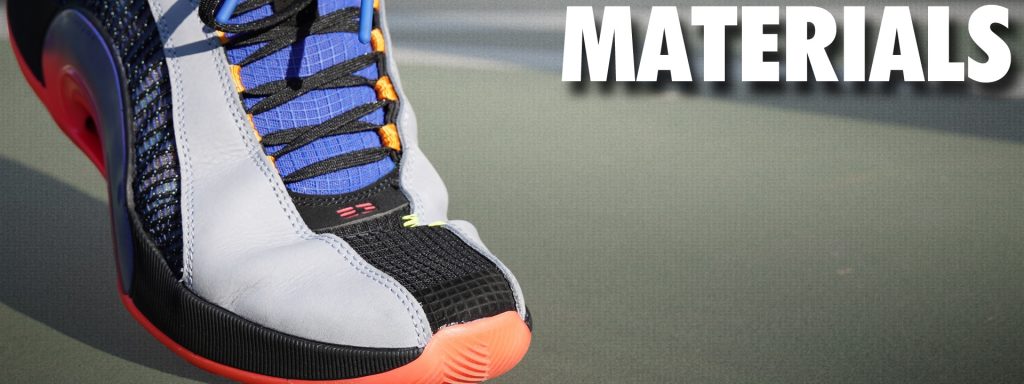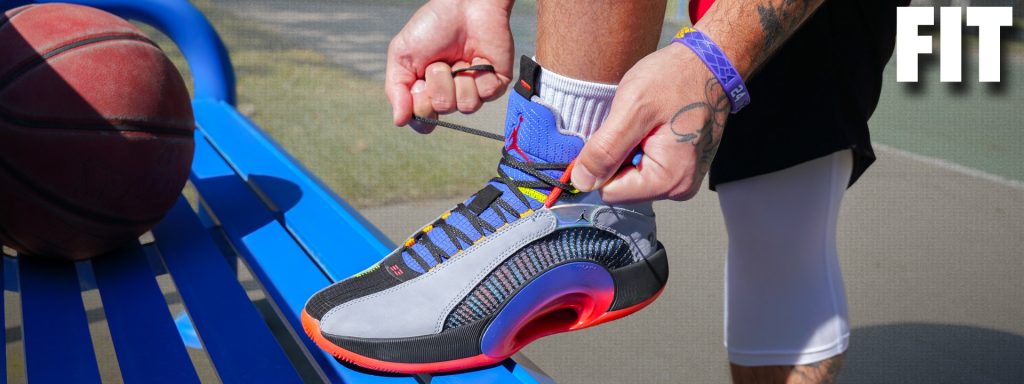Just in time for its initial October 17, 2020 release, our Air Jordan 35 performance review is ready for you to read or watch. From two separate perspectives, we deliver everything you need to know about the most recent flagship Jordan.
Traction

The traction, while altered a bit, doesn’t truly differ from last year’s Air Jordan 34 — which is a good thing as the Jordan 34 was a beast on every surface I played on. To be honest, I still keep the Air Jordan 34 in my bag just in case I’m not feeling whatever I may be testing. Whether it be the regular version, the Jordan 34 SE, or the Jordan 34 Low, the shoe is in my bag at all times due to the amazing traction. Ultra reliable and ready to go any day of the week. Just as it is here on the Air Jordan 35.
Like the Air Jordan 34, the traction isn’t durable enough for outdoor use. But if you’re not an outdoor player then you won’t have to worry. If you are, well, the traction works great. It’s just really thin and will wear down quickly.

If it ain’t broken, don’t fix it. Tried and true herringbone is here to stay with the Air Jordan 35 and it was fantastic. Minor modifications were done to the toe area along with the heel getting reversed herringbone grooves, but it worked super well. The traction sticks. The rubber is soft yet pliable, but it won’t last too long for outdoor courts. The rubber bites well after you break in the outsole coating. yet I don’t think I’ve wiped my shoe once. (Wipe my shoes from playing outdoors during a pandemic? I think not!) Now Jordan Brand, please keep herringbone for future models. We dig it and it works!

Cushion

Unlocked Zoom Air is back and there’s more of it this time around. The forefoot hasn’t changed between the Jordan 34 and Jordan 35 in terms of the Zoom’s size, but the implementation is slightly different. There is only one cavity where the Zoom is exposed and I felt this housed the cushioning a bit more than it had in the Jordan 34. So, less of the amazing Zoom-y feeling that I loved from the previous model.
However, the heel is much improved as the Hex Zoom unit from the Jordan 34 has been replaced with a large heel Zoom Air unit. Much like the forefoot, the Zoom-y feeling is muted a bit, but the impact protection is there. Larger players along with those that play on their heels should enjoy these a bit more.

Did someone say Zoom? Your darn right I did. Zoom in the forefoot is the same size as used in the Jordan 34. A larger volume Zoom unit is used in the heel (compared to last year’s hex unit). It wasn’t as bouncy from the start but after about 20-30 minutes, that forefoot Zoom Air felt good and snappy. It offered responsiveness along with stability and court feel. Despite the Heel Zoom Air unit being changed, I didn’t feel it as much. However, that doesn’t mean it didn’t work. I crashed the boards hard and my knees felt good when landing. It also gave me a nice transition from heel to toe when starting a fast break. I appreciate Jordan Brand sticking with heel and forefoot Zoom.

Materials

This is where I feel you get a slight upgrade from the regular Jordan 34 as Jordan Brand has brought raw materials back to the flagship shoe. Yes, the Jordan 34 SE was full of beautiful leather, but that was an SE — not the true flagship.
The overlay materials will change with colorways. Some will feature leather while others feature suede. It gives the $180 price point a bit of a premium feel and helps relax your mind a bit when spending such a high price for a basketball shoe. Yes, performance is the most important aspect, but some fans still buy the annual Air Jordan just to wear and not to play in. Those fans should be pleased.
For the modern hooper, there is still plenty of lightweight textile around the main build of the shoe. It offers a ton of ventilation and requires no break in time.

Upgraded. Nuff said. The blend of premium raw materials along with modern textiles was implemented because of insight provided by Jordan Brand athletes. The suede and leather combined with Flightwire gave the shoe a more upgraded and durable feel. Kurim was utilized to help with the caging underneath the Flightwire The kurim provides extra support along with a newly updated Eclipse Plate 2.0. What’s funny is that the premium materials inserted didn’t add much weight to the shoe. The Jordan 35 felt much lighter than its predecessor. Some of the interior build of the shoe seemed to be recycled from the Jordan 34. For example, the nylon lace loops and their location. Not necessarily a bad thing, but we’ll discuss that later on.

Fit

The Air Jordan 35 fits true to size so that is what I would recommend for most foot shapes.
However, the fit is also where I had an issue with the shoe. The nylon lace cables that run down to the footbed did a number on my arches. I had noticed the issue on the very first night of testing and immediately took the shoes off. Unfortunately, it was too late and the damage was already done. There needs to be more of a buffer between the foot and the cables. Some padding, a thicker inner sleeve…something. Taping is something I would do just to avoid the issue. Although, you’ll likely still feel them trying to gnaw at your feet. Yes, I’ve been trying everything and I just find this portion of the design to be a flaw. I’m surprised it wasn’t caught during wear-testing.
The rest of the shoe fits and locks the foot down perfectly. It’s a shame that the arch area is affected the way it is. I hope others that play in the shoe don’t have to deal with the same issue. It’s one of the more painful injuries I end up encountering when testing shoes and it takes forever to heal up.

Initially, the Jordan 35 started off a little snug. However, after a few quick movements and a little bit of playing, the shoe really contours to your foot. As a slightly wide footer, I’m still able to stay true to size and they feel fan-freakin-tastic. Lockdown was solid once you get the lacing adjusted correctly. This shoe was made for anyone’s feet, whether narrow, normal, or wide
没有评论:
发表评论